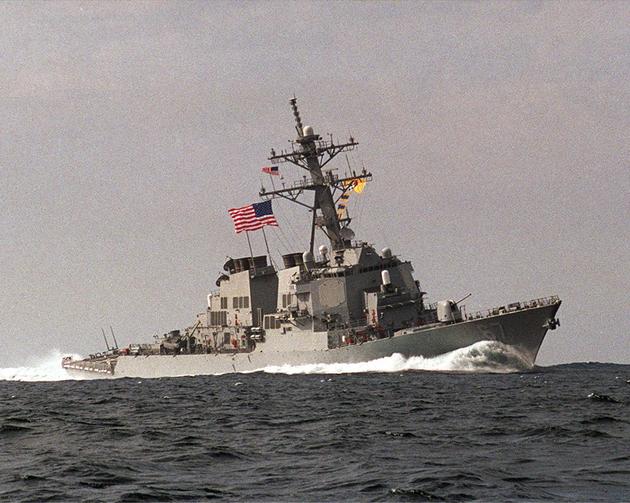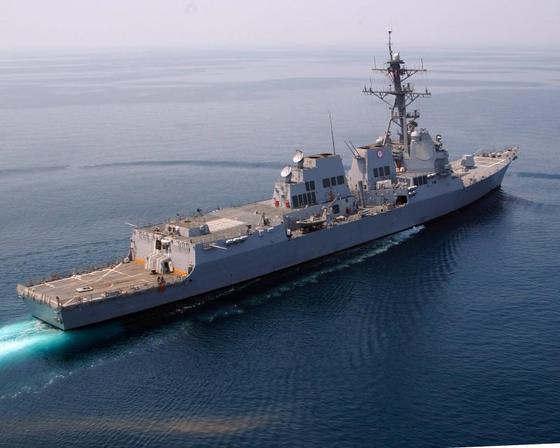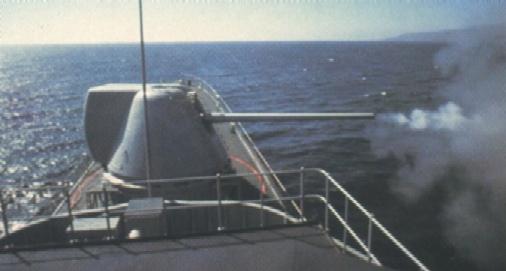September 22, 2008
Fire support is on the radar again as the Navy's solution to the problem seems to be in trouble.
The on again off again saga of the DDG1000 has hit another snag. The program has been cut to a tech demonstrator of two hulls, and then increased to 3 hulls, possibly for industrial capacity reasons.
Now there is apparently a nontrivial issue
with affixing the composite superstructure to the hull. This could
actually kill the program. Unless a better composite material can be
found, this could require a complete redesign of the vessel...which at
this point in the troubled program could well be a program ender.
First some background and explanation.

The DDG 1000 was conceived during the 90s as a fire support vessel
in part to replace the old battleships. It grew as new weapons systems
were added and became quite expensive. These ships are designed to take
a huge ammount of punishment and they have very robust scantlings and
thick shell plating...up to 20mm thick which is nearly as thick as the
unarmored sections of a battleship. There are also design features
associated with stealth that are giving some naval experts pause, such
as the sloped sides (tumblehome) They are designed around 2
experimental 155 mm guns and have 80 missile tubes. Its development
has been troubled to say the least, in no small part because virtually
every piece of equipment outside of the galley, laundry, rope locker
and the 2 Bofors guns is new and experimental..

The ships referred to as Arleigh Burke class destroyers
are actually 3 similar classes of warship that are based on the same
basic design. The later ships have helicopter hangers for 2 Seahawk
helicopters which greatly enhances their peacetime potential and anti
submarine capability.

However, the latest ships omit some useful secondary systems as
an austerity measure. The vessels were rather long in development and
were designed at the height of the cold war to replace obsolete guided
missle destroyers designed in the 50s and 60s. They were intended as
carrier escorts and have a version of the AEGIS air defense system
which makes them extremely effective anti aircraft ships. They were
also designed with attention paid to toughness but they are still built
to destroyer standards. The vessels are designed around percieved cold
war needs, the gun was very much an afterthought as were the helicopter
araingements which are located right aft for maximum pitching in a
seaway. Their soft power projection ability is limited and they are
really expensive ships to be risking inshore. These vessels are well
liked and have a fine reputation for reliability, though expensive to
build and maintain they are, on a ton for ton basis fairly economical
when considering their firepower and targeting capability.
Keeping in mind the situation with the DDG 1000 program, Danger Room! reports that there is interest in fitting new 'Burkes with some additional kit like the AGS gun. This is problematic to say the least.
The Advanced Gun System is HUGE...Naval architects say it would
displace the forward VLS nest as well as the 5 inch gun, cutting the
ships missile capability by one third. It would mean a lot of weight
forward which is problematic for seakeeping and that much weight and
recoil would require design changes that a 3rd class enlisted Coastie
can't even begin to get his head around. The Danger Room! post also
notes that magazine capacity would be a miserable 120 rounds
The AGS Advanced Gun System
is a 155mm (6.1 inch) cannon intended to fire shells about 100 miles
away. Its a lot bigger and heavier than its medium caliber (a standard
caliber for NATO armies) would lead one to believe. This weapon, at
~100 tons, is as heavy as the main guns on some battleships! It fires
a shell that is actually heavier than most 8" shells from WW2. In the
1990s an 8 inch 60-62 caliber weapon was successfully tested , however
the 155mm shell diameter was chosen in part in anticipation of using
standard NATO ammunition for less demanding shots. This was mistaken as
the NATO shells can't actually be fired from the gun as developed.
(
Caliber in large guns generally refers to the length of the barrel
multiplied by the diameter so a 5 inch 54 caliber gun is 270 inches
long. Longer barrels can, in theory, achieve higher velocities. )
The Navy currently uses 2 types of medium sized guns, both 5 inchers. The old 5"54 caliber weapon developed in the 60s is supposed to be replaced with the 5"62 caliber gun. This can fire the old ammunition at a higher velocity and was intended to fire a new super long ranged guided round the EGRM as far as 60 miles but that has been canceled
by the current congress. The 5" guns are reliable but have limited
hitting power. They are probably adequate for most cases though.
At the lower end of the scale The USN and USCG have, since the 1970s used a license built version the old Italian OTO Melera 76mm (3inch)
gun for frigates and the larger Coast Guard cutters. This weapon is
reliable and very popular around the world but is no longer state of
the art. There are much more modern versions of it available.
Instead of going with those versions, the Navy, after a series of tests, decided on a 57mm gun originally developed in Sweden. It is a modernized version of a weapon that has given good service overseas for 40 years and fires twice as fast as the fastest 3" guns available. It is a better anti missile weapon and, surprisingly, has a longer range than the current 3"weapon.
This weapon is the 'main gun' on the Littoral Combat Ships. The 57mm weapon has some utility because, with a rate of fire of 4 rounds a second, its effect has been likened to a cluster bomb going off. However, its six pound shell is half as powerful as the 3 incher and neither is generally considered an adequate shore bombardment weapon. In fact the Brits determined in the 1960s that something in the vicinity of 105mm was the minimum as fire support needs to provide indirect fire...that is lobbing over hills and such.
So, if the AGS system is not going to go to sea any time soon, what might we do to give Uncle Sams Misguided Children fire support both on and off the beach?
This
does not just mean air strike or launching cruise missiles. This
requires being able to hit targets, possibly moving targets exactly
where the ground forces tell you. It means firing a lot of times (and
missiles are bulky) It also means giving close support and escort
landing craft, or (food convoys) all the way to the beach. Note that
the ground forces might not be Marines or Army but could be allied
forces in joint operations.
In the immediate term this is
going to involve sending very large expensive ships with large crews
inshore to shoot at bad guys with their 5 inch guns. If the targets are
in 5 inch gun range the ships are within the range of much
unpleasantness in the form of guns, missiles and torpedoes. This is a
suboptimal solution but its all we have.
In the near term, if the program is not nixed, we have the Littoral Combat ships. One option might be to fit a bigger gun than the 57mm, but these are lightly built vessels and it is unlikely they could take a 5" gun.
There is an interesting option however......and that is the French 100mm gun. (gasp!)

The export version is shown above on a Malaysian OPV. It is also used by China and a few other nations. It weighs 14 tons...which makes an interesting comparison with the 14 ton 57mm weapon already fitted.
That is not entirely true since the 14 tons only includes 114 rounds of ammo, a magazine and ancillary equipment brings its total to 18 tons, which is still quite close to the current weapon (and the additional weights would be low in the hull). The version the French use themselves has some whistles and bells (like local control) that bring it to 22 tons. Even this might still be doable with a slight redesign of subsequent versions of the LCS.
The French arrived at this weapon after considerable testing. It is intended to be light enough for effective AAA fire and fire a heavy enough shell for shore bombardment. Indeed, it was intended as the main weapon of French Avisos (colonial gunboats) and incorporated the fire support lessons of the Indochina War. The shells are about 30 pounds and while less than half the weight of the 5" weapon these have a better chance of taking out a pillbox or a tank than the 57mm gun. The AAA rounds proximity fuse can likely ruin an infantry platoons whole day. The weapon is already developed, highly regarded and the gun and ammunition is in use with several nations, including Argentina, Brazil and Uruguay in the Americas. It could meaningfully upgrade the capability of the LCS in surface combat.
18 tons-22 tons is pretty light, this weapon could be fitted to fairly small vessels (It is used on 1300 ton OPVs ) that would be built in greater numbers.
On the debit side the weapon uses nonstandard ammunition and parts.
To get around that there is the possibility of marinizing a 105mm artillery piece such as that used in the Striker MGS or the Buford light tank.
This
would have the advantage from the defense procurement officials
standpoint of expending lots of unnecessary money and time to achieve
almost the same results as buying an off the shelf weapon....but
without any AAA capability. On the other hand using standard NATO 105mm
ammunition could be advantageous and such a system might be very light
indeed both of which might discourage this approach. (What...ME cynical?)
There is a discussion of this here where Tony Williams notes a UK project along these lines involving a tank turret that weighed 6 tons!?.....damn...put two of them on a Cyclone
or similar small ship! There are likely to be issues with this approach
but it is an interesting idea nonetheless. 6 tons puts it in the
capability of some VERY small craft.
Of course one of the
complaints about fire support is that the current weapons are too
small, and going with a gun that is half as powerful does not address
that. To that end the UK is developing a marinized version of its 155mm artilery piece.
Intended to fit in the same turret as a standard Royal Navy 4.5 inch
gun the weapon or something like it would be a good replacement for the
5 inch guns on USN cruisers and destroyers giving considerably more
hitting power and perhaps even an increase in range now that the EGRM
round has been canceled. Whether this is worthwhile is debatable.
On a tangent...The old Cruisers of the Ticonderoga class were actually strengthened and had space reserved to take an 8 inch gun that was developed in the 70s, though its unclear if...1: we could build those guns now or 2: if they could still take these weapons after their many upgrades. If it could be produced, it could certainly be fitted to specially designed new build ships of modest size.....as it was a successful weapon and the tests were actually conducted from an old (2800 ton) Forrest Sherman Class destroyer.

Guns are the most economical in space but missiles can be useful too. For really heavy artillery the Army's GMLRS rockets
are quite impressive, carrying a precision guided 200 pound warhead 40
miles away. The warhead on this 9" diameter rocket is bigger than the
bursting charge of a 16" shell. These can't be fired from warships for
a variety of reasons, however in 1999 Lockmart proposed POLAR, The
Precision Over the horizon Land Attack Rocket which is mentioned
briefly here
used a marinized and lengthened version of the same weapon that could
be packed 4 per cell in a vertical launch tube and would have had a
range of over 100 miles. Hitting nearly as hard as a battleship gun
from 5 times the distance and with precision guidance and
being relatively cheap this weapon would have solved the heavy fire
support problem at a stroke, but was canceled. It could probably be
revived without too much trouble Many of these options have been
looked at before and were rejected in favor of the AGS which, being a
battleship sized weapon, requires a ship as big as a predreadnaught to
carry it with any efficiency.
Posted by: The Brickmuppet at
09:40 PM
| No Comments
| Add Comment
Post contains 2158 words, total size 16 kb.
67 queries taking 0.1373 seconds, 179 records returned.
Powered by Minx 1.1.6c-pink.









